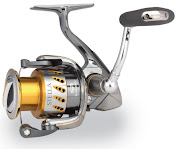Hold the rod horizontally in front of you. The handles should be on top of the reel, that is, pointing UP if you're right-handed (using a right-handed reel). This is similar to the way you would hold a tennis racket and gives the widest possible range of movement to your wrist.
With your thumb applying pressure directly on the spool, unlock it, using whatever mechanism is used (thumb bar, pushbutton, etc.). The pressure of your thumb against the spool is what's preventing it from moving at this point.
Bring the rod up over your shoulder to approximately the
Now bring the rod forward as if you were trying to hammer a nail in a wall in front of you, but use a smooth motion; this is NOT the time for forceful movements! As the rod reaches the
While you are practicing (yes, you are going to need to practice with this reel), back off on the brake just a little at a time. Eventually you will get more comfortable with the new settings and you should be able to cast farther. Experiment with different settings with the brake and spool. The whole trick to using the baitcasting reel is the use of the thumb. Applying and releasing pressure to the spool with your thumb is the key to this system, and you must master it.
Throwing too hard will snag you up. Throw a moderate distance until you get used to it. As you get better at this, you will see your distance improve. Make sure it is your wrist that is doing the casting. To learn to do this take a small object similar to a pack of smokes, deck of cards, etc., and place it between your inner bicep and your side and practice casting without dropping the object. This will force you to use your wrist primarily and when you get better you can add different arm strokes to suit.
After you've practiced using the suggested adjustments and get a good feel of things, you will gradually be able to reduce the amount of tension and braking force, as you simultaneously "educate" your thumb.
Put your thumb on the line to hold it in place while you click the line release button. Cast the lure by releasing the thumb pressure, but keep the thumb barely touching the line (using your thumb for anything but very lightly feathering of the spool at any other point only cuts down on your distance and isn't the best way to maintain control over the cast; that's what brakes are for).
As the lure reaches its destination, apply more pressure with the thumb as a brake and to keep the line from spooling off into a bird's nest. It takes a lot of practice to get the right touch.
Finally, if you can master the basic cast, and achieve both control and comfort, then it truly becomes a matter of practice and more practice for distance, accuracy and versatility.



















With your thumb applying pressure directly on the spool, unlock it, using whatever mechanism is used (thumb bar, pushbutton, etc.). The pressure of your thumb against the spool is what's preventing it from moving at this point,this is useful idea for fishing,
ReplyDeleteTerm papers
I will be at the Classic in a few weeks and I cannot wait to see (and feel) this thing. https://guidancesports.com/
ReplyDelete